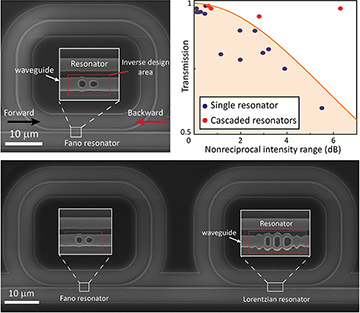 Left: SEM images of the single-ring device (top) and cascaded device (bottom). Upper right: Transmission versus nonreciprocal-power-range performance for several single-ring (blue dots) and cascaded (red dots) devices. Single-ring devices are bound to lay in the shaded area. [Enlarge figure]
Left: SEM images of the single-ring device (top) and cascaded device (bottom). Upper right: Transmission versus nonreciprocal-power-range performance for several single-ring (blue dots) and cascaded (red dots) devices. Single-ring devices are bound to lay in the shaded area. [Enlarge figure]
Nonreciprocal devices, which allow light to propagate asymmetrically along opposite directions,1 are crucial components for optical communications, nonlinear signal processing and all-optical circuits in silicon-compatible photonic platforms. Nonreciprocity and isolation are traditionally achieved in free-space optics by biasing magneto-optic materials, but this technique lacks CMOS compatibility. In recent work,2 we combined state-of-the-art fabrication and inverse design3 to demonstrate bias-free, low-loss nonreciprocal transmission in silicon integrated devices.
Our approach rests on an alternative route to nonreciprocity, involving optical nonlinearities combined with geometrical asymmetries. In an asymmetric two-port resonator, the intra-cavity intensity (for given input power) depends on the excitation direction. A strong χ(3) nonlinearity, such as the Kerr effect in silicon, induces a shift of the resonator frequency, the magnitude of which depends on the stored intensity and, thus, on the excitation port. Since the resonator frequency controls the port-to-port transmission, this mechanism can lead to large nonreciprocity within certain power ranges, especially when highly asymmetric Fano profiles are engineered.4 While limited to specific forms of excitation, this approach is attractive in that it requires no external biasing field and can be realized in standard integrated optical waveguides.
The geometry of our device consists of a single ring resonator, side-coupled to a waveguide through an inverse-designed coupler. The background reflectivity and geometrical asymmetry can be varied arbitrarily by the coupler geometry and its position along the waveguide. We demonstrated a transmission contrast larger than 20 dB in a power range of 4.5 dBm, together with record-low insertion loss of 1.1 dB.
Importantly, the forward transmission and power range over which nonreciprocity occurs are not independent parameters and cannot be maximized simultaneously.4 We provided the first experimental verification of this bound by characterizing different devices. The precise control of the background reflectivity, obtained via the inverse-designed reflector, allows us to optimize the two metrics on demand.
To go beyond this transmission/power-range trade-off, following previous work,5 we experimentally demonstrated that this bound can be overcome by adding a second silicon ring at a tailored distance from the first one.2 This cascaded device features a nonreciprocal power range of 6.3 dB and a forward transmission up to 98%, largely beating the single-resonator bound.
These passive, bias-free nonreciprocal devices can be particularly useful for the protection of pulsed sources, and are well suited for time-of-flight lidar systems, as we showed in a proof of principle.2 The sub-dB insertion loss, simple design and self-biased operation make these devices very attractive from a technological standpoint, and we expect them to find wide application for nonreciprocal signal routing in integrated photonic chips.
Researchers
Ki Youl Yang, Jinhie Skarda, Avik Dutt, Geun Ho Ahn, Mahmoud Sawaby, Dries Vercruysse, Amin Arbabian, Shanhui Fan and Jelena Vučković, Stanford University, Stanford, CA, USA
Michele Cotrufo and Andrea Alù, CUNY Advanced Science Research Center, New York, NY, USA
References
1. C. Caloz et al. Phys. Rev. Appl. 10, 047001 (2018).
2. K.Y. Yang et al. Nat. Photon. 14, 369 (2020).
3. A.Y. Piggott et al. Nat. Photon. 9, 374 (2015).
4. D.L. Sounas and A. Alù. Phys. Rev. B 97, 115431 (2018).
5. D.L. Sounas et al. Nat. Electron. 1, 113 (2018).

